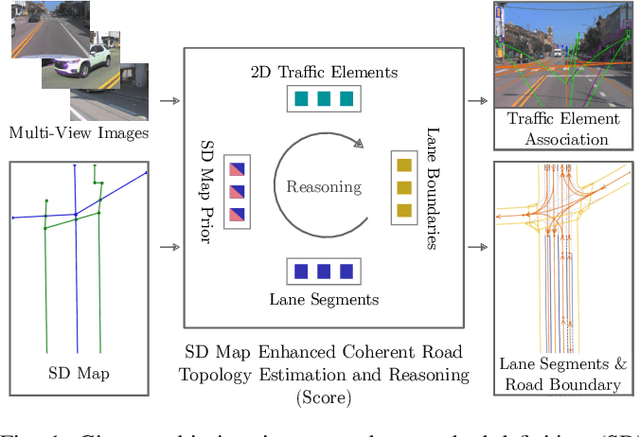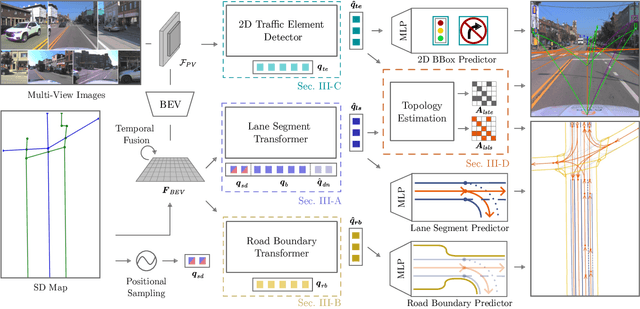Johannes Betz
A Kalman Filter-Based Disturbance Observer for Steer-by-Wire Systems
Dec 29, 2025Abstract:Steer-by-Wire systems replace mechanical linkages, which provide benefits like weight reduction, design flexibility, and compatibility with autonomous driving. However, they are susceptible to high-frequency disturbances from unintentional driver torque, known as driver impedance, which can degrade steering performance. Existing approaches either rely on direct torque sensors, which are costly and impractical, or lack the temporal resolution to capture rapid, high-frequency driver-induced disturbances. We address this limitation by designing a Kalman filter-based disturbance observer that estimates high-frequency driver torque using only motor state measurements. We model the drivers passive torque as an extended state using a PT1-lag approximation and integrate it into both linear and nonlinear Steer-by-Wire system models. In this paper, we present the design, implementation and simulation of this disturbance observer with an evaluation of different Kalman filter variants. Our findings indicate that the proposed disturbance observer accurately reconstructs driver-induced disturbances with only minimal delay 14ms. We show that a nonlinear extended Kalman Filter outperforms its linear counterpart in handling frictional nonlinearities, improving estimation during transitions from static to dynamic friction. Given the study's methodology, it was unavoidable to rely on simulation-based validation rather than real-world experimentation. Further studies are needed to investigate the robustness of the observers under real-world driving conditions.
Unsupervised Learning for Detection of Rare Driving Scenarios
Dec 29, 2025Abstract:The detection of rare and hazardous driving scenarios is a critical challenge for ensuring the safety and reliability of autonomous systems. This research explores an unsupervised learning framework for detecting rare and extreme driving scenarios using naturalistic driving data (NDD). We leverage the recently proposed Deep Isolation Forest (DIF), an anomaly detection algorithm that combines neural network-based feature representations with Isolation Forests (IFs), to identify non-linear and complex anomalies. Data from perception modules, capturing vehicle dynamics and environmental conditions, is preprocessed into structured statistical features extracted from sliding windows. The framework incorporates t-distributed stochastic neighbor embedding (t-SNE) for dimensionality reduction and visualization, enabling better interpretability of detected anomalies. Evaluation is conducted using a proxy ground truth, combining quantitative metrics with qualitative video frame inspection. Our results demonstrate that the proposed approach effectively identifies rare and hazardous driving scenarios, providing a scalable solution for anomaly detection in autonomous driving systems. Given the study's methodology, it was unavoidable to depend on proxy ground truth and manually defined feature combinations, which do not encompass the full range of real-world driving anomalies or their nuanced contextual dependencies.
RoGER-SLAM: A Robust Gaussian Splatting SLAM System for Noisy and Low-light Environment Resilience
Oct 26, 2025Abstract:The reliability of Simultaneous Localization and Mapping (SLAM) is severely constrained in environments where visual inputs suffer from noise and low illumination. Although recent 3D Gaussian Splatting (3DGS) based SLAM frameworks achieve high-fidelity mapping under clean conditions, they remain vulnerable to compounded degradations that degrade mapping and tracking performance. A key observation underlying our work is that the original 3DGS rendering pipeline inherently behaves as an implicit low-pass filter, attenuating high-frequency noise but also risking over-smoothing. Building on this insight, we propose RoGER-SLAM, a robust 3DGS SLAM system tailored for noise and low-light resilience. The framework integrates three innovations: a Structure-Preserving Robust Fusion (SP-RoFusion) mechanism that couples rendered appearance, depth, and edge cues; an adaptive tracking objective with residual balancing regularization; and a Contrastive Language-Image Pretraining (CLIP)-based enhancement module, selectively activated under compounded degradations to restore semantic and structural fidelity. Comprehensive experiments on Replica, TUM, and real-world sequences show that RoGER-SLAM consistently improves trajectory accuracy and reconstruction quality compared with other 3DGS-SLAM systems, especially under adverse imaging conditions.
Enhancing Physical Consistency in Lightweight World Models
Sep 15, 2025Abstract:A major challenge in deploying world models is the trade-off between size and performance. Large world models can capture rich physical dynamics but require massive computing resources, making them impractical for edge devices. Small world models are easier to deploy but often struggle to learn accurate physics, leading to poor predictions. We propose the Physics-Informed BEV World Model (PIWM), a compact model designed to efficiently capture physical interactions in bird's-eye-view (BEV) representations. PIWM uses Soft Mask during training to improve dynamic object modeling and future prediction. We also introduce a simple yet effective technique, Warm Start, for inference to enhance prediction quality with a zero-shot model. Experiments show that at the same parameter scale (400M), PIWM surpasses the baseline by 60.6% in weighted overall score. Moreover, even when compared with the largest baseline model (400M), the smallest PIWM (130M Soft Mask) achieves a 7.4% higher weighted overall score with a 28% faster inference speed.
Model-Structured Neural Networks to Control the Steering Dynamics of Autonomous Race Cars
Jul 27, 2025Abstract:Autonomous racing has gained increasing attention in recent years, as a safe environment to accelerate the development of motion planning and control methods for autonomous driving. Deep learning models, predominantly based on neural networks (NNs), have demonstrated significant potential in modeling the vehicle dynamics and in performing various tasks in autonomous driving. However, their black-box nature is critical in the context of autonomous racing, where safety and robustness demand a thorough understanding of the decision-making algorithms. To address this challenge, this paper proposes MS-NN-steer, a new Model-Structured Neural Network for vehicle steering control, integrating the prior knowledge of the nonlinear vehicle dynamics into the neural architecture. The proposed controller is validated using real-world data from the Abu Dhabi Autonomous Racing League (A2RL) competition, with full-scale autonomous race cars. In comparison with general-purpose NNs, MS-NN-steer is shown to achieve better accuracy and generalization with small training datasets, while being less sensitive to the weights' initialization. Also, MS-NN-steer outperforms the steering controller used by the A2RL winning team. Our implementation is available open-source in a GitHub repository.
Towards Safe Autonomous Driving: A Real-Time Safeguarding Concept for Motion Planning Algorithms
Jul 10, 2025Abstract:Ensuring the functional safety of motion planning modules in autonomous vehicles remains a critical challenge, especially when dealing with complex or learning-based software. Online verification has emerged as a promising approach to monitor such systems at runtime, yet its integration into embedded real-time environments remains limited. This work presents a safeguarding concept for motion planning that extends prior approaches by introducing a time safeguard. While existing methods focus on geometric and dynamic feasibility, our approach additionally monitors the temporal consistency of planning outputs to ensure timely system response. A prototypical implementation on a real-time operating system evaluates trajectory candidates using constraint-based feasibility checks and cost-based plausibility metrics. Preliminary results show that the safeguarding module operates within real-time bounds and effectively detects unsafe trajectories. However, the full integration of the time safeguard logic and fallback strategies is ongoing. This study contributes a modular and extensible framework for runtime trajectory verification and highlights key aspects for deployment on automotive-grade hardware. Future work includes completing the safeguarding logic and validating its effectiveness through hardware-in-the-loop simulations and vehicle-based testing. The code is available at: https://github.com/TUM-AVS/motion-planning-supervisor
Coherent Online Road Topology Estimation and Reasoning with Standard-Definition Maps
Jul 02, 2025



Abstract:Most autonomous cars rely on the availability of high-definition (HD) maps. Current research aims to address this constraint by directly predicting HD map elements from onboard sensors and reasoning about the relationships between the predicted map and traffic elements. Despite recent advancements, the coherent online construction of HD maps remains a challenging endeavor, as it necessitates modeling the high complexity of road topologies in a unified and consistent manner. To address this challenge, we propose a coherent approach to predict lane segments and their corresponding topology, as well as road boundaries, all by leveraging prior map information represented by commonly available standard-definition (SD) maps. We propose a network architecture, which leverages hybrid lane segment encodings comprising prior information and denoising techniques to enhance training stability and performance. Furthermore, we facilitate past frames for temporal consistency. Our experimental evaluation demonstrates that our approach outperforms previous methods by a large margin, highlighting the benefits of our modeling scheme.
Foundation Models in Autonomous Driving: A Survey on Scenario Generation and Scenario Analysis
Jun 13, 2025Abstract:For autonomous vehicles, safe navigation in complex environments depends on handling a broad range of diverse and rare driving scenarios. Simulation- and scenario-based testing have emerged as key approaches to development and validation of autonomous driving systems. Traditional scenario generation relies on rule-based systems, knowledge-driven models, and data-driven synthesis, often producing limited diversity and unrealistic safety-critical cases. With the emergence of foundation models, which represent a new generation of pre-trained, general-purpose AI models, developers can process heterogeneous inputs (e.g., natural language, sensor data, HD maps, and control actions), enabling the synthesis and interpretation of complex driving scenarios. In this paper, we conduct a survey about the application of foundation models for scenario generation and scenario analysis in autonomous driving (as of May 2025). Our survey presents a unified taxonomy that includes large language models, vision-language models, multimodal large language models, diffusion models, and world models for the generation and analysis of autonomous driving scenarios. In addition, we review the methodologies, open-source datasets, simulation platforms, and benchmark challenges, and we examine the evaluation metrics tailored explicitly to scenario generation and analysis. Finally, the survey concludes by highlighting the open challenges and research questions, and outlining promising future research directions. All reviewed papers are listed in a continuously maintained repository, which contains supplementary materials and is available at https://github.com/TUM-AVS/FM-for-Scenario-Generation-Analysis.
MIND-Stack: Modular, Interpretable, End-to-End Differentiability for Autonomous Navigation
May 27, 2025Abstract:Developing robust, efficient navigation algorithms is challenging. Rule-based methods offer interpretability and modularity but struggle with learning from large datasets, while end-to-end neural networks excel in learning but lack transparency and modularity. In this paper, we present MIND-Stack, a modular software stack consisting of a localization network and a Stanley Controller with intermediate human interpretable state representations and end-to-end differentiability. Our approach enables the upstream localization module to reduce the downstream control error, extending its role beyond state estimation. Unlike existing research on differentiable algorithms that either lack modules of the autonomous stack to span from sensor input to actuator output or real-world implementation, MIND-Stack offers both capabilities. We conduct experiments that demonstrate the ability of the localization module to reduce the downstream control loss through its end-to-end differentiability while offering better performance than state-of-the-art algorithms. We showcase sim-to-real capabilities by deploying the algorithm on a real-world embedded autonomous platform with limited computation power and demonstrate simultaneous training of both the localization and controller towards one goal. While MIND-Stack shows good results, we discuss the incorporation of additional modules from the autonomous navigation pipeline in the future, promising even greater stability and performance in the next iterations of the framework.
MultiDrive: A Co-Simulation Framework Bridging 2D and 3D Driving Simulation for AV Software Validation
May 20, 2025Abstract:Scenario-based testing using simulations is a cornerstone of Autonomous Vehicles (AVs) software validation. So far, developers needed to choose between low-fidelity 2D simulators to explore the scenario space efficiently, and high-fidelity 3D simulators to study relevant scenarios in more detail, thus reducing testing costs while mitigating the sim-to-real gap. This paper presents a novel framework that leverages multi-agent co-simulation and procedural scenario generation to support scenario-based testing across low- and high-fidelity simulators for the development of motion planning algorithms. Our framework limits the effort required to transition scenarios between simulators and automates experiment execution, trajectory analysis, and visualization. Experiments with a reference motion planner show that our framework uncovers discrepancies between the planner's intended and actual behavior, thus exposing weaknesses in planning assumptions under more realistic conditions. Our framework is available at: https://github.com/TUM-AVS/MultiDrive
 Add to Chrome
Add to Chrome Add to Firefox
Add to Firefox Add to Edge
Add to Edge